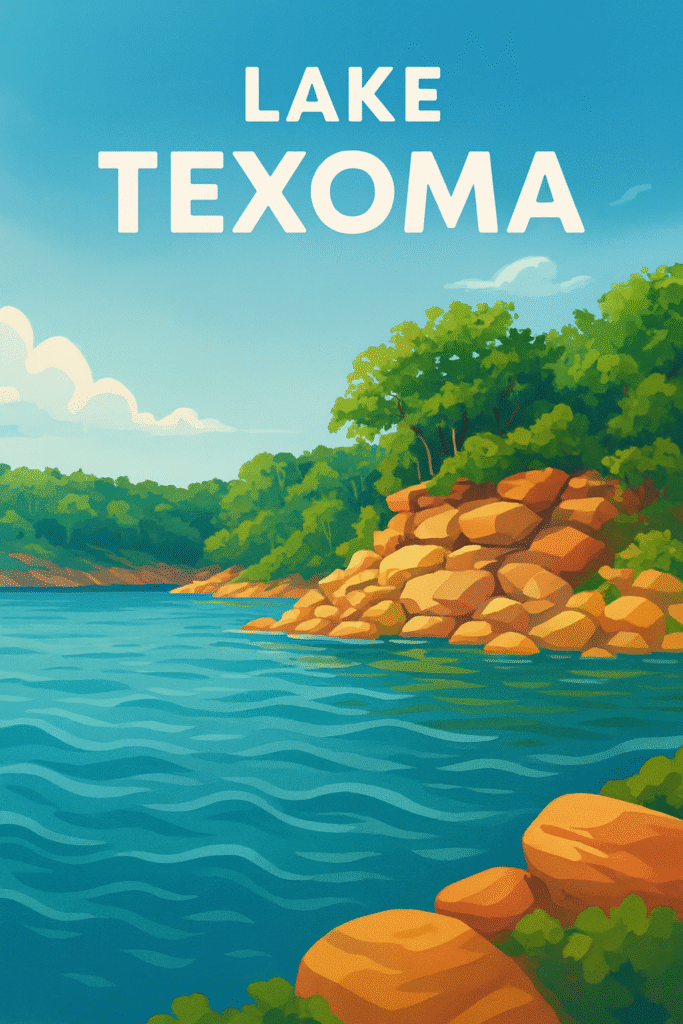Lake Texoma is one of the largest and most popular lakes in the southern United States. It sits on the border of Texas and Oklahoma and is known for its beauty, history, and many fun activities. This guide will take you through the story of the lake, its natural features, and what you can do if you visit. The goal is to give you an easy-to-read, friendly, and detailed picture of this amazing place.
Location and Size
Lake Texoma lies where the Red River and Washita River meet. It spreads across Grayson and Cooke counties in Texas and Marshall, Bryan, Johnston, and Love counties in Oklahoma. The lake covers about 89,000 acres of water and has more than 1,200 miles of shoreline. Because of its size, it is often called one of the largest reservoirs in the United States. Its normal water level is around 615 to 619 feet above sea level.
How the Lake Was Made

Lake Texoma was formed when the Denison Dam was built on the Red River. The project began in 1939 and finished in 1944. The dam was part of the Flood Control Act of 1938, which aimed to reduce flooding in the region. Denison Dam is an earth-fill embankment dam that is more than 15,000 feet long and about 165 feet high. It was one of the first large dams of its kind and has influenced the design of other dams since.
The dam not only helps control floods but also produces hydroelectric power. During World War II, some German prisoners of war helped with basic construction tasks such as clearing land and building drainage systems. Over the years, the dam has reached its flood level several times, including in 1957, 1990, 2007, and twice in 2015.
Water and Rivers
Two main rivers feed Lake Texoma: the Red River and the Washita River. Several smaller creeks also flow into it. One special feature of the lake is its salty water. The Red River carries salt from ancient underground deposits, which makes the lake different from most other freshwater reservoirs. Because of this, fish like striped bass, which usually live in the sea, can survive and reproduce here. This makes Lake Texoma one of the few inland lakes with a self-sustaining striped bass population.
Wildlife and Fishing
The mix of freshwater and salty water creates a unique home for many kinds of fish. The lake is famous for striped bass, which attract thousands of anglers every year. Other fish include largemouth bass, white bass, crappie, catfish, and walleye. In 2004, a blue catfish weighing 121.5 pounds was caught here, setting a record at the time. Because of its fishing opportunities, Lake Texoma is sometimes called the “Striper Capital.”
Birds, deer, and other wildlife also live in the areas around the lake. The shoreline has wooded areas, rocky cliffs, and open plains, making it a rich habitat for many species.
Recreation and Tourism
Lake Texoma welcomes around six million visitors each year. People come for boating, sailing, swimming, camping, hiking, horseback riding, and picnicking. The lake has more than 50 parks and recreation areas managed by the U.S. Army Corps of Engineers. There are also many private marinas, resorts, and rental cabins for visitors.
Two main state parks are located by the lake. In Oklahoma, there is Lake Texoma State Park, and in Texas, there is Eisenhower State Park, named after President Dwight D. Eisenhower, who was born in nearby Denison, Texas. For hiking lovers, the Cross Timbers Trail runs for about 14 miles along the lake and offers beautiful views of the water and cliffs.
One of the most popular events at Lake Texoma is the Lakefest Regatta, a sailing race that attracts many boats and visitors. It is one of the first inland charity regattas in the United States.
History and Culture
Before the lake was built, Native American tribes lived along the Red River, and settlers used the land for farming. When Denison Dam was built, some areas were flooded, and people had to move. During the early years, recreation facilities at the lake were affected by racial segregation. Separate areas were built for white and Black visitors during the Jim Crow era. Some of these historic sites have since been removed, but they remain part of the lake’s history.
At first, the National Park Service managed the recreation areas, but by 1949, control was given fully to the U.S. Army Corps of Engineers. Over time, private companies developed parts of the shoreline into resorts, homes, and marinas.
In recent years, the boundary between Texas and Oklahoma has been adjusted slightly to make sure that certain facilities, like water stations, are fully under one state.
Water Levels Today
Lake Texoma’s water levels change with the seasons and rainfall. At its normal level, it holds more than 2.4 million acre-feet of water. When heavy rains come, the level rises into the flood pool, which protects downstream areas from flooding. The dam also releases water at times to keep the lake safe and stable.
Why Lake Texoma Is Important

Lake Texoma is more than just a lake. It is an important source of recreation, water supply, and power. It helps control floods, supports local wildlife, and draws millions of visitors each year, which brings money to the local economy. At the same time, the lake faces challenges. Salt in the water affects its quality, and keeping the dam and facilities in good shape is a constant task. Balancing human use with nature protection is always important for its future.
Conclusion
Lake Texoma is a place where history, nature, and fun come together. From its start with Denison Dam to its role today as a top recreation spot, the lake continues to be a special part of both Texas and Oklahoma. Whether you love fishing, camping, or just enjoying the view, Lake Texoma has something for everyone. It is a reminder of how people and nature can shape each other over time.
Frequently Asked Questions
1. Where is Lake Texoma located?
It is on the border of Texas and Oklahoma, on the Red River.
2. How big is Lake Texoma?
It covers about 89,000 acres of water and has more than 1,200 miles of shoreline.
3. Who built Lake Texoma?
It was built by the U.S. Army Corps of Engineers through the construction of Denison Dam.
4. When was Lake Texoma created?
Construction began in 1939 and was finished in 1944.
5. Why is Lake Texoma salty?
The Red River brings in salt from ancient underground deposits.
6. What kind of fish live in Lake Texoma?
Striped bass, catfish, crappie, white bass, largemouth bass, and walleye are common.
7. What activities can visitors enjoy?
Boating, fishing, swimming, camping, hiking, horseback riding, and sailing.
8. Are there state parks near the lake?
Yes, Lake Texoma State Park in Oklahoma and Eisenhower State Park in Texas.
9. How many people visit Lake Texoma each year?
About six million visitors come each year.
10. Why is Lake Texoma important?
It provides recreation, flood control, hydroelectric power, wildlife habitat, and supports local economies.
Connect with us for more information : Blog Pioneer

